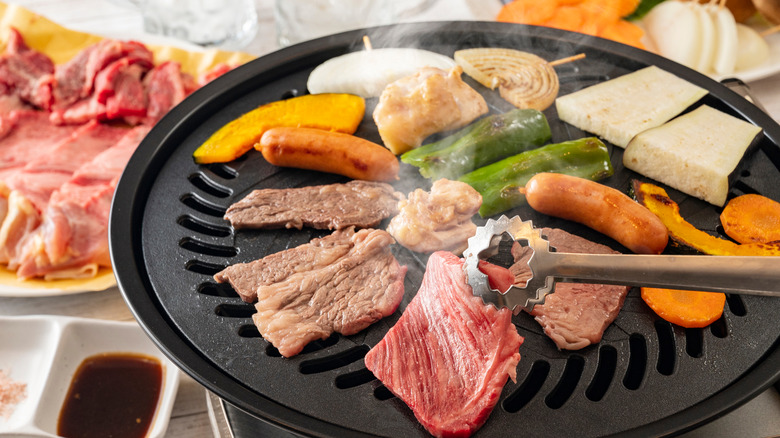Japanese-Style Grilling Reminds Us To Savor Simplicity
The sizzle and aroma of meat on the grill are irresistible. Around the world, meat is grilled in a myriad of ways, but none is more mouth-watering than the Japanese method known as yakiniku. The star of Japanese-style grilling is the meat itself, often premium beef cuts like ribeye or sirloin. Rather than relying on complex marinades, yakiniku opts for simplicity — a sprinkle of salt and pepper or a classic soy sauce-based marinade called tare is all that's needed. Even the specialty binchotan charcoal used is designed not to add flavors to the meat, in contrast to the intensely smoky American mesquite charcoals. This minimalist approach allows the natural richness of the meat to shine through.
One theory suggests that the origins of yakiniku can be traced back to the period just after World War II, when Koreans in Japan introduced their style of barbecuing meat. Enterprising Japanese chefs and restaurant owners began adapting Korean barbecue techniques to cater to local palates. Diners enjoyed the savory aroma of bite-sized pieces of meat cooked right at their tables, and the method soon found its way into home cooking as well. Yakiniku is both a social activity and a meal, intended to be shared with friends and family.
Quality and simplicity shine on the grill
The essence of this Japanese grilling tradition rests on thin slices of premium cuts like ribeye, sirloin, and chicken thigh, where exceptional marbling and tenderness are paramount. The quality of the meat not only ensures a melt-in-your-mouth experience, but also dictates the depth of flavor. The rich, buttery texture and inherent succulence of these cuts enhance the dish's simplicity, transforming it into an unforgettable culinary experience. The same can be said for other meats, seafood, and even vegetables grilled in the Japanese style — the high quality speaks for itself and is elevated, not masked, by the seasoning.
In tandem with the quality of the meat, the simple dipping sauces, known as tare, contribute to yakiniku's memorable flavors. These sauces come in regional variations but most commonly feature a blend of soy sauce, mirin, sake, sugar, and sometimes garlic or sesame. The balance of salty, sweet, and umami notes in tare sauce complements the grilled items, enhancing their natural flavors without overwhelming them. You can find yakiniku cuts of meat at Japanese grocery stores; why not experience the flavor and simplicity for yourself?

